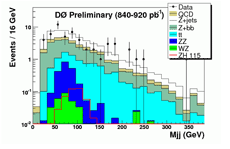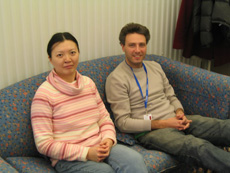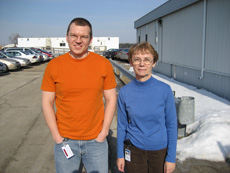|
Thurs., February 22
10:00 a.m.
Research Techniques Seminar -
Curia II
Speaker: A. Curioni, Yale University
Title: Experimental Study of Neutrino Interactions on Ar with
a Liquid Ar Time Projection Chamber
11:00 a.m.
Academic Lecture Series -
1 West
Speaker: A. Kronfeld, Fermilab
Title: Course 5, Part 1: Lattice QCD with Applications
to B Physics
1:30 p.m.
Particle Astrophysics Seminar -
Curia II
Speaker: D. Croton, University of California, Berkeley
Title: How to Model the Universe in N Easy Steps (N>>1)
2:30 p.m.
Theoretical Physics Seminar -
Curia II
Speaker: R. Hill, Fermilab
Title: Topological Interactions of Higgs Bosons
3:30 p.m.
DIRECTOR'S COFFEE BREAK -
2nd Flr X-Over
4:00 p.m.
Accelerator Physics and Technology Seminar -
1 West
Speaker: C. Antoine, Saclay
Title: Superconducting RF Cavities and Materials Issues
*There will be no
ALCPG ILC Physics and Detector Seminar today
Fri., February 23
3:30 p.m. Director's Coffee Break - 2nd floor crossover
4:00 p.m.
Joint Experimental Theoretical Physics Seminar -
1 West
Speaker: M. Chanowitz, Lawrence Berkeley National Laboratory
Title: Precision Electroweak Data and the Higgs Boson Mass
Click here for NALCAL,
a weekly calendar with links to additional information. |
Thursday, February 22
-Southwestern Chicken Tortilla
-Philly Style Cheese Steak
-Garlic Herb Roasted Pork
-Tomato Basil Chicken Parmesan
-Smoked Turkey Melt
-Southwestern Turkey Wrap
-Marinated Grilled Chicken Caesar Salads
Wilson Hall Cafe Menu |
|
Thursday, February 22
"Carnival" Celebration - (book now at x4598)
Sancocho
Roast Suckling Pig
Moro y Cristanos
Chayote Guisado
Pineapple Flan & Tropical Fruit
Wednesday, February 28
Lunch
-Northern Italian Lasagna
-Caesar Salad
-Cassata
Chez Leon Menu
Call x4598 to make your reservation. |
|
|
Herman White to give 'crash course' at Boston conference

The NSBP conference is being held in Boston from February 21 to February 25.
Fermilab physicist Herman White is offering a crash course in physics terms
for undergraduate attendees at the annual conference of the National Society
of Black Physicists in Boston. "Right now, it looks like the tutorial talk
will be at 8:30 in the morning [Thursday]," White said from his cell phone
yesterday, as he waited to catch a ride to Harvard. "The idea is to give the
undergraduate students a little working knowledge about physics before they
go to the more advanced talks during the rest of the meeting."
 |
| Herman White |
The annual conference, held jointly with the National Society of Hispanic
Physicists, connects more than 500 minority physicists, students and
professionals from institutions and universities across the country. "It's a
chance for African-American and Hispanic physicists to interact with one
another, and also get a chance to stimulate the students," said White. "The
goal is to offer exposure and motivation to students who might be interested
physics, and to give them access to a path they might want to pursue."
White first learned of the precursor to NSBP more than 30 years ago, during an informal
meeting of African-American physicists held at Fermilab in 1974. "That was the first
time that I knew an organized group of African-American physicists existed," said
White. The group was officially founded under its current name in 1977, and Fermilab hosted an NSBP meeting four years after that, bringing together
luminaries such as Shirley Jackson, who had previously conducted research at
Fermilab and was then working at Bell Laboratories, and Michael Burns of
NASA's Goddard Space Flight Center. Fermilab's Elliot Treadwell gave a talk
at the 1981 meeting, and White compiled the proceedings, which are available
in the Fermilab library.
At this year's meeting, White looks forward to mingling with colleagues as
well as connecting with students. "I have the program in my hand, and it has
40 pages-worth of talks," he said. "It will certainly be exciting."
--Siri Steiner
Read more about this year's conference on the NSBP Website.

Participants of the 1981 NSBP meeting take a tour of Fermilab.
|
Widening the Gateway to India

The 'Gateway to India' in Mumbai.
By typing in a simple command on Monday, February 12, Gavin McCance initiated the first file transfer between CERN and India on the Worldwide LHC Computing Grid.
Connection via the WLCG will give Indian researchers the same level of access to Large Hadron Collider particle physics experiments as researchers in European or North American countries.
"It's a good feeling to be involved in a collaboration like this," says McCance, WLCG/CERN.
Read More
|
|

Thick as pea soup: AD's
Charlie King sent this picture of yesterday's dense fog, which dropped
visibility to less than a quarter-mile in some areas.
|
Scientific American
March 2007 issue:
Alone at the Top
The world's biggest accelerator, the Large Hadron Collider (LHC) at CERN, the European laboratory for particle physics near Geneva, will come on line in a few months. Even so, for the next few years it may have a hard time upstaging the Tevatron collider at Fermi National Accelerator Laboratory (Fermilab) in Batavia, Ill., which appears to have generated "single" top quarks. The finding, reported last December, helps to narrow the search for the long sought after Higgs particle and raises the possibility that Fermilab will find it before the LHC does.
Read More (subscription required) |
|
|
Every bit counts!


See descriptions below*
As the Tevatron continues to deliver record amounts of data to the DZero and CDF experiments, hope is rising that we'll soon catch a glimpse of the elusive Higgs boson. But finding the Higgs is no easy task. If the Higgs is relatively light, it would predominantly decay into a pair of bottom quarks, with little to distinguish them from the millions of other bottom quark pairs made at the Tevatron each day. Fortunately, the Higgs will sometimes appear together with a W or Z boson, which are far rarer. If the W or Z decays to leptons, such as electrons, muons, or neutrinos, they are particularly easy to identify.
Unfortunately, the subatomic world is populated with other processes that have very similar signatures. And to make matters worse, most of the interesting W and Z boson decays include neutrinos which are not detected at all. The "missing" energy of the neutrinos can be partially inferred, but the absent information makes it difficult to reconstruct exactly what happened after the proton and anti-proton initially collided in the center of the detector. But when the Z boson decays to a pair of electrons or muons, there are no missing pieces to the puzzle and the possible counterfeit Higgs signatures are greatly reduced. Although this search channel is rare, it is a very bright spotlight to shine into any dark corners where the Higgs might be hiding.
Researchers at the DZero experiment have recently completed a search in this channel using about 1 inverse femtobarn of data--nearly all the data delivered to the DZero experiment up to June 2006. There is no sign of the Higgs boson yet, especially in this channel alone. However, these results represent a powerful addition to the full Tevatron Higgs search. By combining with other search channels, physicists are casting an increasingly broad net in this subatomic fishing expedition. As more data pours in every day, the DZero Higgs search is ready to make the biggest catch of all.
*Upper graphic: The invariant mass of the two bottom quarks selected in this analysis. The Higgs boson is expected to be a small, peaked resonance (shown in red for mH=115 GeV/c^2) amongst larger background processes. Also shown are the observed data events in roughly 1 inverse femtobarn. Lower Graphic: A candidate Z boson plus Higgs boson event, as seen by the DZero detector. The Higgs decays to two bottom quarks (red & blue calorimeter energy depositions), while the Z decays to two muons (green muon system measurements). The reconstructed paths of charged particles are shown in black.

Above: Shaohua Fu (FNAL) and Andy Haas (Columbia University) contributed to this Higgs boson search. Below: Dmitri Smirnov, Jadwiga Warchol (Notre Dame), and Paul Rubinov (FNAL, not pictured) perform the careful maintenance required for the Central Fiber Tracker readout electronics. The robust operation of the CFT is essential to analyses that select bottom quarks.

|
|
Submissions for URA Thesis Award
due before March 1
Fermilab and Universities Research Association invite
submissions for the tenth annual URA Thesis Award Competition.
The award recognizes the most outstanding thesis related to
work performed at Fermilab or in collaboration with Fermilab
scientists and must have been completed in the 2006 calendar year.
Nominations must be submitted to Richard Tesarek (tesarek@fnal.gov)
by March 1, 2007 and should include a letter supporting the
merits of the thesis being nominated. (Theses can be uploaded to Tech Pubs.)
Selection will be made by
the Thesis Awards Committee. Each thesis will be judged on clarity
of presentation, originality and physics content. To qualify, the
thesis must have been submitted as partial fulfillment of the Ph.D
requirements and be written in English, and it must have been submitted
in electronic form to the Fermilab Publications Office in accordance
with Fermilab policy. The recipient of the award will receive a
certificate of recognition and a check for $3000.
Upcoming Activities
|
|